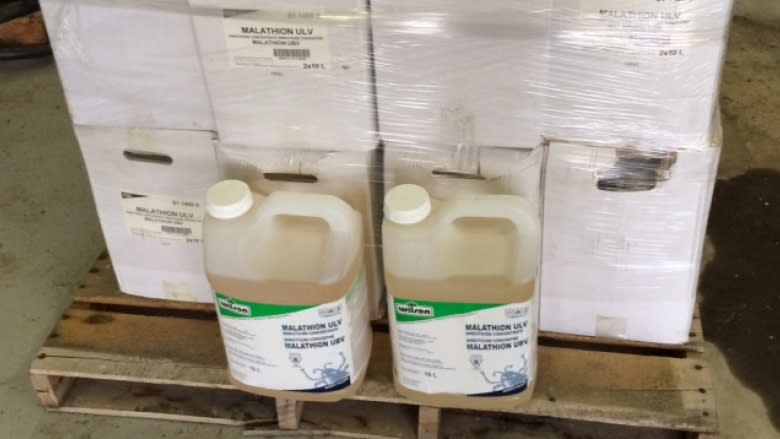Dissecting insecticide: What you need to know about Winnipeg's new mosquito killer
When it comes to killing the always aggravating mosquito, the city has a new tool if fogging is required: deltamethrin.
The insecticide will be replacing the controversial malathion, which Winnipeg used for decades, but a science project manager with the David Suzuki Foundation says neither choice is consequence-free when it comes to the environment or our health.
"Switching from malathion to deltamethrin may be switching for the lesser of two evils," Louise Henault-Ethier said.
Deltamethrin is in the pyrethroid family of insecticides, which Henault-Ethier researched for a 2016 paper for the non-governmental organization Équiterre. Health Canada only approved the use of the product for mosquito fogging on Friday.
"The evaluation found that, under the approved conditions of use, the products have value and do not present an unacceptable risk to human health or the environment," Health Canada said in its decision statement online.
While pyrethroids are less toxic than malathion, an organophosphate insecticide, Henault-Ethier said deltamethrin can also have larger impacts than just killing pesky mosquitoes.
What are pyrethroids?
Pyrethroids are similar to the natural pyrethrins produced by chrysanthemum flowers.
Pyrethrin has been used since the Napoleonic Wars when it was a popular treatment for soldiers that had lice, but the problem was the flower extract would degrade rapidly under sunlight and in water.
Henault-Ethier said when synthetic chemistry became more advanced, the pyrethrin molecules were slightly modified to make them last longer and more efficiently kill the insects — creating a new class of compounds, called pyrethroids.
The insecticide became more popular in the 1990s to replace organophosphates like malathion, which actually were developed to replace dichlorodiphenyltrichloroethane (DDT).
"Every time we switch we think it's a safer choice but eventually, a couple years down the road, we figured there was toxicity that had not been seen," Henault-Ethier said.
Taz Stuart, an entomologist with Poulin's Pest Control Services in Winnipeg, said while pyrethroids are rooted in natural products and malathion is synthetic, both have shown similar effectiveness in killing mosquitoes.
"It will kill mosquitoes, of course, it just depends on conditions. That's key. Any product that is designed to kill, will kill," he said.
How do they work?
Pyrethroids are extensively used in a lot of different products from household insecticides to greenhouses.
Henault-Ethier said pyrethroids disrupt an insect's nervous system, eventually causing its death. While all pyrethroids have a similar chemical formula, the chemical molecules can be slightly tweaked to provide different benefits, she said.
So, if you want to kill ants, you may want the ant to bring the insecticide back to its ant hill, so the chemicals would be changed slightly to act more slowly. With mosquitoes, Henault-Ethier said insecticides should cause a more immediate death.
That means that deltamethrin, the insecticide Winnipeg is using, is one of the most toxic in the pyrethroid family.
"It is low compared to all other insecticides, but compared to other pyrethroids it is one of the most [active]," Henault-Ethier said.
Stuart said that smaller amounts of pyrethroids will be needed to destroy the insects in Winnipeg when compared to malathion.
What happens if a person is exposed?
The City of Winnipeg respects buffer zones and crews will not spray within 90 metres of each side of a registered property.
Health Canada's Pest Management Regulatory Agency said that according to exposure models, people likely won't have any symptoms from deltamethrin unless they are exposed to about 100 times the amount of insecticide allowed to be sprayed in the city.
Henault-Ethier said if it does touch the skin, people might have a tingling sensation. Ingestion, which is unlikely, may cause a sore throat, nausea, vomiting and abdominal pain, but most effects are reversible in a couple of hours. That's not always the case with malathion, she said.
Stuart added malathion and deltamethrin are both less toxic than table salt when ingested.
"With a new product everything has its own risks of course. At the end of the day, malathion, we knew it long-term and we knew its issues," he said.
"We will find out how [deltamethrin] fares if we have a season of lots of adult nuisance adult mosquitoes."
However, with prolonged exposure over time, Henault-Ethier said there is some evidence to show a correlation with serious health conditions. In her report, she quoted a Chinese study which showed pyrethroid exposure is correlated with a decrease in sperm count and motility.
She said she was also concerned because pyrethroids can be toxic to cells involved in the development and maintenance of the brain, with links to cognitive and behavioural issues in children.
Health Canada's Pest Management Regulatory Agency said deltamethrin fell in acceptable level of risk and a 2009 review by the United States Environmental Protection Agency concluded there was no clear and consistent pattern between pyrethroids and asthma or allergies.
Henault-Ethier said that the link is difficult to conclusively prove but there are enough studies showing correlation that it needs to be closely monitored.
"With pyrethroids in general we may become worried about reproductive decrease and cognitive impairments [but] those symptoms will not be known … until that population has been exposed to it," she said.
Are there environmental impacts?
Pyrethroids' purpose is to kill bothersome bugs, but sometimes it can also cause unintended destruction, Henault-Ethiersaid.
Pyrethroids are not very water soluble and they bind to soil and sediments, Henault-Ethier said, particularly deltamethrin. That means it can take more than 30 to 100 days to leave the environment after it has been used.
"It's not one of the most persistent insecticides," Henault-Ethier said, adding other insecticides can stay in the environment forever. "But it can stay there for long enough to harm."
Bees may be particularly at risk from pyrethroid insecticides, she said, adding that if the direct spraying doesn't kill them, if they forage on flowers following the fogging they can still be exposed.
It may also reduce insect populations too much, meaning other animals could starve.
"[It]can reduce aquatic insect populations [which] harms birds, bats and other species dependent on an abundant food supply," she said.
Studies in the U.S. have also shown a faster resistance build up to deltamethrin, although Stuart said Winnipeg's winters should help slow that down. He added every insecticide has breakdown products which could build up in the environment.
"This is the hard part. You assume it's safe, you assume everything is good, as long as you are following the label directions it should be fine using it," he said.
The Pest Management Regulatory Agency said deltamethrin, when used for control of adult mosquitoes, is not expected to cause harm to animal populations, bees, beneficial insects or aquatic life.
While Henault-Ethier said there are still risks when it comes to deltamethrin, it is a better option than malathion and can be helpful when treating outbreaks like West Nile virus.
"If there is a risk of disease obviously cover yourself, do all that you can to avoid the threat of that disease and do all you can to avoid the spread of the diseased mosquito," she said.
"But if you can avoid this type of exposure, just because mosquitoes are considered a nuisance because they bite you and it's uncomfortable, then I would strongly argue in favour of using alternate methods."
Stuart said it's important to try alternative products and monitor their effectiveness.
"It's one of those new products you see what happens, every year is different, hopefully it's successful. If it's not we have to find something else," he said.
"[I] want to see the best and most safest products used for the citizens of Winnipeg."



